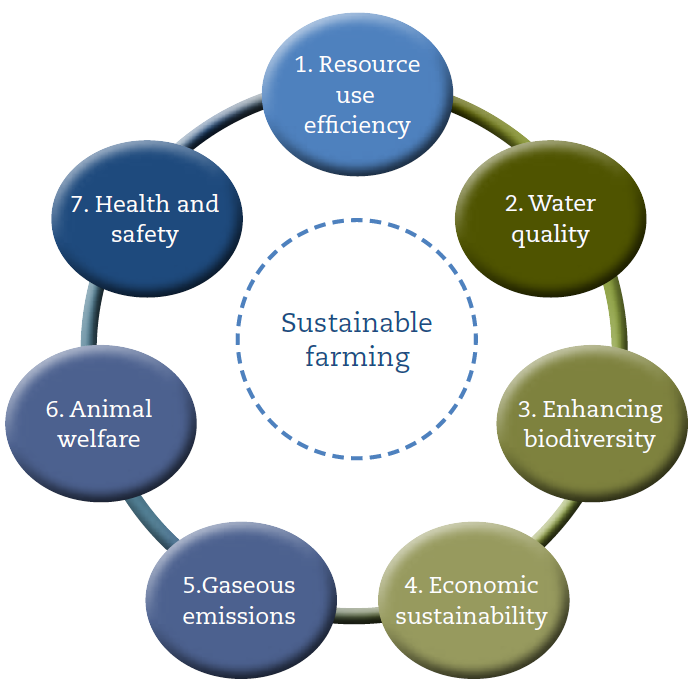Introduction to Kildalton Open Source Sustainable Demonstration Farm

Global demand for food is projected to double by 2050 and, with concurrent challenges presented by climate change and increasing greenhouse gas emissions.
To meet this demand and protect our natural resources will require sustainable production practices. The Kildalton Open Source Sustainable Demonstration Farm, supported by Glanbia Ingredients Ireland has been set up to promote and transfer the sustainable farming message.
Food Wise 2025 was launched in 2015 and sets out a sustainable growth vision for the Irish agri-food sector. As Ireland’s farmers manage the majority of the country’s natural resources, it places them in a unique position of delivering many public goods and social benefits, which contribute to the wellbeing of the country. In doing so, Irish producers are playing, and must continue to play, a vital and positive role in the protection and the potential further enhancement of Ireland’s landscapes, waterways, biodiversity and air quality. This position is particularly important given the increased global demand for food where current projections predict that by 2050 the demand will have doubled. Ireland has a track record of sustainable food production and we are in a good position to deliver sustainably produced food while better protecting our natural resources.
Origin Green and Glanbia
Origin Green was introduced in 2012 by Bord Bia and was the first national sustainability programme uniting Government, the private sector and food producers. The programme involves on-going measurement throughout both farm and food manufacturing units. Participating farms are assessed on an 18-month cycle on measures ranging from their carbon footprint to water, energy and biodiversity. To date, over 90,000 farms have been audited and carbon footprinted as part of Origin Green
Glanbia Ingredients Ireland (GII) has recognised its comparative advantages in sustainability as a key difference between it and its competitors in global dairy markets. Consequently, the company has prioritised the drive to develop the sustainability of its products along the food chain from the farm to the customer.
GII is a key partner in the Kildalton Open Source Sustainable Demonstration Farm, providing financial support and technical expertise. GII is a founding member of Origin Green and in preparing its milk suppliers for auditing and, further developing its sustainable approach; Glanbia has developed the Glanbia Open Source Sustainability and Quality Assurance code.
Objectives
The Kildalton Open Source Sustainable Demonstration Farm builds on the large body of research and knowledge-transfer experience in Teagasc and draws on international knowledge to showcase solutions to the economic and environmental sustainability challenges facing the Irish agri-food industry.
Collaborating with GII, work has started on the high output dairy unit (463kg milk solids per cow) at Kildalton to transform it into a showcase of sustainable dairy production.

Figure 1. Soil testing and grass monitoring are key elements ensuring we get best value from nutrient inputs.
Defining and measuring sustainable farming
While there is universal agreement on the desirability of the concept of sustainable agriculture, there are differences on how it is interpreted. There is general agreement that sustainability should be considered under three pillars: economic, environmental and social.
It is common for most analysis to be focused on the environmental dimension. Echoing the 1987 Brundtland Report, Teagasc has succinctly defined sustainable agriculture as an approach that we can sustain into the foreseeable future. This project focuses on seven dimensions of sustainability: resource use efficiency; water quality; biodiversity; economic sustainability; gaseous emissions; animal welfare; and health and safety. These sustainability variables are not independent and links can exist between them, e.g., spreading slurry using low-emission technologies can reduce greenhouse gas emissions but may also reduce impacts on water quality.

Figure 2. Seven elements of sustainable farming.
Implementing the sustainable farming plan
In summary the plan can be summarised as being delivered over four distinct phases, although these phases will overlap with each other to some degree.
- Phase 1: Benchmarking the sustainability performance of the farm to provide a baseline against which future changes can be measured.
- Phase 2: Implementation of proven technologies and best practices.
- Phase 3: Redesign and improvement of the farm infrastructure (including ecological infrastructure).
- Phase 4: Step-by-step implementation of emerging technologies.
Progress on implementation
A project coordinator was successfully recruited and work commenced in 2016. As per Phase 1, a baseline is being established with the installation of electricity and water metering, soil sampling of the entire farm, establishment of nutrient-use efficiencies, completion of annual carbon navigators, participation in the National Farm Survey, mapping biodiversity resources, development of animal welfare metrics and installation of sampling points for ground and surface waters.
Further work is needed in developing a baseline, namely carrying out spring surveys of biodiversity elements, e.g., birds, hedgerows, woodland etc., and developing a water quality baseline. In line with the showcasing element of the project, there have been visits from international dairy processors, food manufacturers and academia. The farm also hosted the Irish Grassland Association student conference.
Work in 2017 will carry on the baseline assessments but will also progress to a greater adoption of proven technologies and best practices, including a field trial of protected urea and greater establishment of clover through overseeding with white clover and correcting soil pH and nutrient status. Recent research from Johnstown Castle shows that urea protected with the urease inhibitor N-(n-butyl) thiophosphoric triamide (NBPT) reduces greenhouse gas emissions compared to calcium ammonium nitrate (CAN). Protected urea also consistently yields as well as CAN and has higher fertilizer efficiency than urea (Forrestal et al., 2017) because of reduced ammonia gas loss. Protected urea products are now available from several fertilizer companies in Ireland and the Kildalton Sustainable farm will integrate protected urea into its fertilizer plan.

Figure 3. Improving local habitats will have positive impacts for biodiversity and also improve the provision of other ecosystem services such as climate regulation and aesthetic.
First Published 10 April 2017
Tagged with: Dairy
